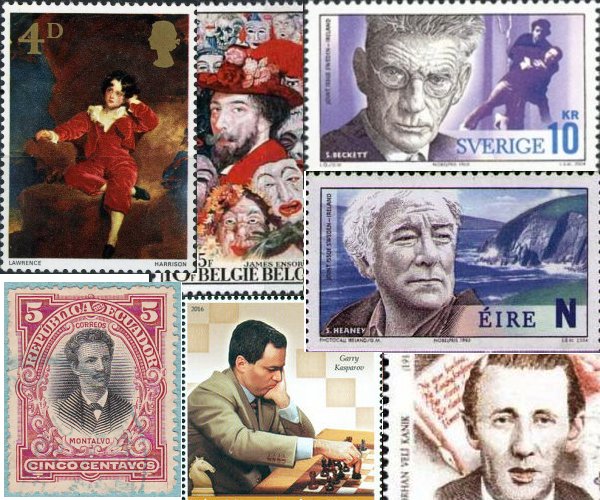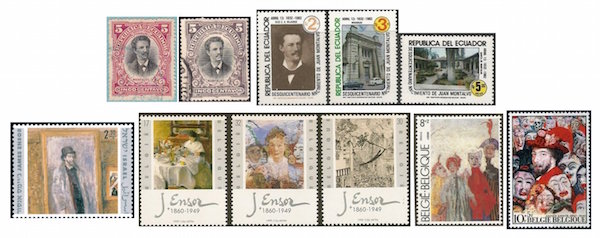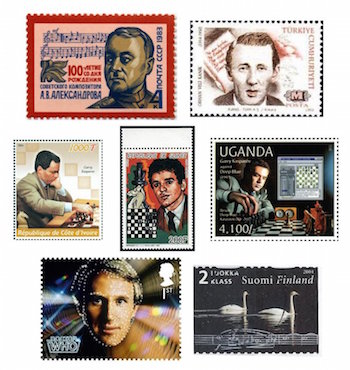The Arts on the Stamps of the World — April 13
An Arts Fuse regular feature: the arts on stamps of the world.

By Doug Briscoe
After a bit of a dry spell stampwise, today we are back in full flood, with painters Sir Thomas Lawrence and Baron Ensor, Irish literati Samuel Beckett and Seamus Heaney (yes, they were born on the same day, albeit 33 years apart), Russian chess grandmaster Garry Kasparov, another Doctor Who, and four more artists, but, sad to say, nothing for Eudora Welty (April 13, 1909 – July 23, 2001), though I have little doubt that her day in the philatelic sunshine will come.
Sir Thomas Lawrence (13 April 1769 – 7 January 1830) is one of the Big Names in English portrait painting. Stamps of the world give us five examples. The charming Master Lambton of 1825, on a British stamp of 1967, has come to be more popularly known as The Red Boy. The Portuguese stamp was issued to celebrate the centennial of that country’s postage stamps in 1953, but shows a detail from Lawrence’s portrait of Queen Maria II (1829; hard to tell that she was only ten at the time). The stamp from the Turks and Caicos gives us a detail from Lawrence’s exquisite The Calmady Children (1823). This image serves a double purpose today, as April 13 is also the date in 1870 when the Metropolitan Museum of Art was founded, and this picture happens to hang in that gallery. On a stamp from the Isle of Man we see Maria, Lady Callcott (1819), and on the one from Cuba Mrs. Edward Foster (1828).

It’s extraordinary that two of the most prominent Irish men of letters of our time should happen to have been born on the same date, Samuel Beckett in 1906, and Seamus Heaney in 1939. (Beckett was born on Good Friday; Heaney wasn’t.) Beckett the playwright also wrote poetry (and eight novels), and Heaney the poet also wrote two plays (no novels). All four of the Beckett stamps conjure up Waiting for Godot, and three of them refer to Beckett’s 1969 Nobel Prize for Literature. He lived much of his life in Paris and wrote some of his works in the French language. He died on 22 December 1989. Seamus Heaney lived off-and-on in the United States and was affiliated with Harvard from 1981 to 2006. He, too, had a facility with languages and in his later years made translations from the Irish, Latin (Ovid), Polish (Kochanowski), Old English (Beowulf), Czech, and Russian (Pushkin). He died just four years ago on 30 August 2013.
Last year was the bicentenary of the birth of English pianist and composer William Sterndale Bennett (13 April 1816 – 1 February 1875). His early compositions were warmly admired by Mendelssohn and Schumann, who dedicated his Symphonic Etudes to Bennett. Orphaned at age three, Bennett, whose father had been an organist and composer, was brought up by his grandfather, a bass singer. The boy sang with the King’s College Choir at seven and entered the Royal Academy at ten. At seventeen he accepted Mendelssohn’s invitation to Leipzig and on his return joined the faculty of the RAM, which he later directed. His students included Arthur Sullivan, and Hubert Parry. Now in my youth, one could search high and low and far and wide for a William Sterndale Bennett album and come up empty-handed, but I understand that today about 25% of Bennett’s œuvre has been recorded on CD, and he even has a stamp in his honor. O modern age of miracles!
Ecuadorian author Juan Montalvo (April 13, 1832 – January 17, 1889) was a bold anti-clerical and anti-conservative voice who was thrice exiled from his country. The first occasion was as a response to his editorial attack on President Gabriel García Moreno, which resulted in a seven-year banishment to Colombia and, probably, the president’s assassination. Montalvo was twice exiled to France and lived there for the last decade of his life. The stimulus for the final exile was his essay collection Las catilinarias, a book highly critical of the dictator Ignacio de Veintemilla. This book, however, established Montalvo’s intellectual reputation internationally. He also wrote a novel, Capítulos que se le Olvidaron a Cervantes (Chapters Cervantes Forgot), a sequel to Don Quixote. In his earlier days (1857-59) he had been a diplomat in Italy and France, and he founded a half dozen magazines between 1848 and 1872. From the philatelic angle Montalvo is of interest in that he appears on one of the earliest stamps in the world to honor a writer (1899), which I place next to a 1901 reissue (the purple one) and a much more recent (1982) sesquicentennial issue.

James Sidney Edouard, Baron Ensor (13 April 1860 – 19 November 1949) was born in Brussels to an English father and a Belgian mother. A man (or boy) who knew his own heart, he quit school at 15 to study painting, giving his first show at 21. Much of his work raised eyebrows, especially the ironic Christ’s Entry Into Brussels in 1889, in which the Central Figure can barely be seen in the midst of a huge festive crowd in bright colors. He came to be a respected artist by the early 20th century and was even created a baron by King Albert I. His work influenced the impressionist and surrealist movements and artists like Klee and Grosz in particular. Despite the danger, he remained in Ostend through the Second World War, making his daily constitutionals and gradually turning away from painting to spend more time playing the harmonium. The stamp at left was put out by Israel in 1999 as a joint issue with Belgium, to mark the occasion of a touring exhibit of works from the Tel Aviv Museum of Art, to which this painting had been contributed in 1947. It shows a small detail from My Favorite Room (1892). The associated Belgian stamps depict Woman Eating Oysters (1882), Old Lady With Masks (1889, masks being a favorite subject, as we shall see), and Triumph Over Death (1896). Earlier Belgian stamps (from 1984 and 1974) show Les masques singuliers (1892) and My Portrait Surrounded by Masks (1899). Incidentally, the composer Flor Alpaerts (1876–1954) wrote a James Ensor Suite for orchestra in 1931, each of its four movements inspired by a specific Ensor painting.
April 13 (O.S. 1 April) is also the birthday of Soviet composer Alexander Alexandrov (1883 – 8 July 1946). Like Sterndale Bennett, he was a chorister in boyhood (at Kazan Cathedral). He studied with Medtner and became a professor of music in Moscow in 1918. Alexandrov has two particularly notable accomplishments: he wrote, at Stalin’s request, the national anthem of the Soviet Union (since 2000 the anthem of Russia, with new lyrics), and he founded the Alexandrov Ensemble, an official army choir of the Russian armed forces that also includes an orchestra and a dance ensemble.
Turkish poet Orhan Veli Kanik (13 April 1914 – 14 November 1950) was an artistic rebel whose motto might have been “out with the old, in with the new.” In 1941 he and fellow poets Oktay Rifat and Melih Cevdet put out a volume called Garip, thus founding the Garip (or First New) Movement. They eschewed such tired old devices as rhyme, meter, and metaphor. Again, initial negative reaction was gradually supplanted by acceptance and admiration, with the work now being regarded as an important development in Turkish letters. He also translated French (La Fontaine, Maeterlinck, many plays) and English (Charles Lamb) literature into Turkish.

In connection with Bobby Fischer’s birthday I had occasion to say that I regard an elegant game of chess as in some respects a carefully crafted work of art, a thing of genuine beauty. So today, happy birthday to the courageous genius Garry Kasparov (born Garik Kimovich Weinstein on 13 April 1963), grandmaster, World Chess Champion #13 (since the Championships were established in 1886), and political activist who dares to oppose Vladimir Putin and so far has lived to tell about it. Kasparov has been honored on many stamp sheets from Africa.
It’s time for us to acknowledge another Doctor Who, Peter Davison (born Peter Moffett on 13 April 1951). The English actor played the fifth of the dozen Doctors (1981-84) as well as the character of Tristan Farnon in All Creatures Great and Small. Again, the stamp comes from a recent British sheet recalling the first eleven Doctors.
On April 13, 1742 Handel’s Messiah had its world première in Dublin, Ireland. There are many Handel stamps, and there are many Messiah stamps, but there are no Handel’s Messiah stamps.
The original version of Sibelius’s great Lemminkäinen Suite (aka Four Legends of the Kalevala) was premièred on this date in 1896 by the Helsinki Philharmonic. The suite as a whole is not commemorated on stamps, but its most famous (and most beautiful) movement, “The Swan of Tuonela,” is.
A graduate of the University of Massachusetts with a B.A. in English, Doug Briscoe worked in Boston classical music radio, at WCRB, WGBH, and WBUR, for about 25 years, beginning in 1977. He has the curious distinction of having succeeded Robert J. Lurtsema twice, first as host of WGBH’s weekday morning classical music program in 1993, then as host of the weekend program when Robert J.’s health failed in 2000. Doug also wrote liner notes for several of the late Gunther Schuller’s GM Recordings releases as well as program notes for the Boston Classical Orchestra. For the past few years he’s been posting a Facebook “blog” of classical music on stamps of the world, which has now been expanded to encompass all the arts for The Arts Fuse.

